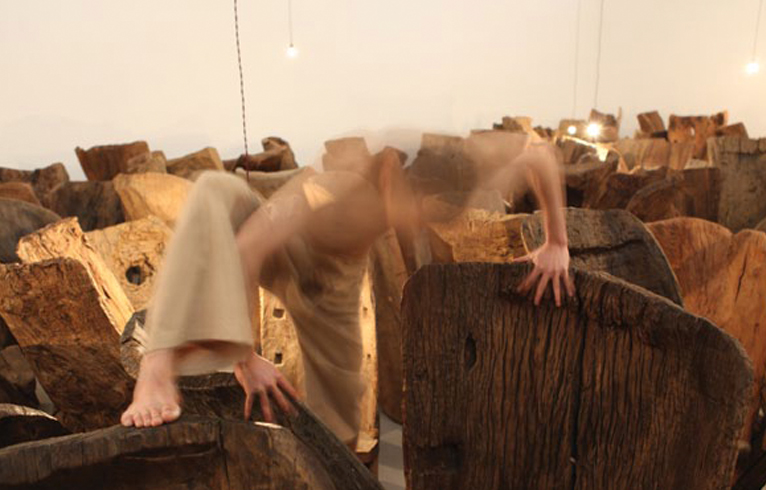HE XIANGYU: MAN ON THE CHAIRS
| 2011年07月14日 | 发表于 LEAP 9

For the performance of Man on The Chairs, a group of trained dancers, following instructions and exerting great effort, clambered back and forth across the gallery space. Admiring this scene, and trying to figure out the narrative of the performance, spectators soon realize that its crux lies in an emphasis of the new “surface” created by the chairs, their conventional function as stage props exaggerated to the extent that they dominated the entire space.
Worth considering is the origin of these wooden chairs. He Xiangyu first salvaged wooden logs from an old canal in a mountainous part of Yunnan, and had them shipped to Beijing. The logs were then sorted, polished and lacquered by carpenters before being cut and grafted into the irregularly shaped chairs that are seen in the exhibition. The chairs, slotted together, look precarious, though they are in fact completely stable. The varied quality of the timber dates back to the building of the canal itself, for which the wood was seemingly selected at random. After years of erosion by wind and water, the now rotten and withered wood imbues the chairs with an atmosphere of bitterness and age, the scars of time lending them a weighty historicity. It was on these chairs that the performers played their seemingly carefree game, the rule of which was to stay aboard the chairs, a fall to the ground signifying death.
As the narrative unfolded, one of the performers, now weary, and unsteadily traversing the chairs, falls to the ground. The other performers try their best to save him. This whole struggle is enacted in complete silence; meanwhile, the otherwise solemn tone of the performance was punctuated by the regular appearance of an expressionless gallery cleaner, who meticulously scrubs the chairs. And so, under the dim glow of old-fashioned light bulbs, a distinctly sociological aspect of this exhibition emerged, clearly betraying He Xiangyu’s understanding of contemporary social structures, hinting at basic human experience, and reflecting a distinctly politicized experience of communality.
Time, life, death, systems, organizations: it isn’t difficult to suss the essential keywords of this exhibition. These themes, new to no one, float in and out of He Xiangyu’s narrative, producing an almost ceremonial atmosphere and lending its language a certain equivocality, ambiguity. The exhibition could be regarded as a piece of theatre, the performance of which took place only on the opening night. Thereafter only the stage set, as well as video documentation of the performance, remained. Subsequent visitors saw only an accidental, residual, historical document.
Objectively speaking, and on a level of logical articulation and formal transferral, this is a clear and concise exhibition, thoroughly considered prior to its realization and consciously peppered with clues to aid possible attempts at its decoding. Though if viewed within a single thematic framework, its formal arrangement remains coherent. Visitors to this exhibition might have some queries regarding the artist’s direct modus operandi; such a rigorous formal exercise is indispensible to the artist’s creative practice.
He Xiangyu is a young artist, but quickly developing a richness material and formal language. This solo exhibition could be viewed as a continuation of his Coca-Cola Project, for which he squandered time, money and human resources boiling over 100 tons of Coca-Cola until it turned into a heap of black crystalline matter. Although on a formal level the two works appear totally different, in their close observation of “matter,” in their planning and transformative process, they are in fact brought under a single compositional rationale. Thus, despite the themes which define Man on the Chairs, this piece could be considered representative of a period of distinct conceptual and thematic focus, and this may make it easier for the observer to unravel its symbolic riddles. However, this exhibition can also be read as the artist’s response to the contemporary political and social atmosphere, even if these particular reverberations were quite possibly not part of his original intentions.
Zhang Xiyuan (Translated by Dominik Salter Dvorak)

